Lupins have a uniquely beautiful flower. Their seeds are also a protein-rich meat substitute for soy that can be grown in your own garden.
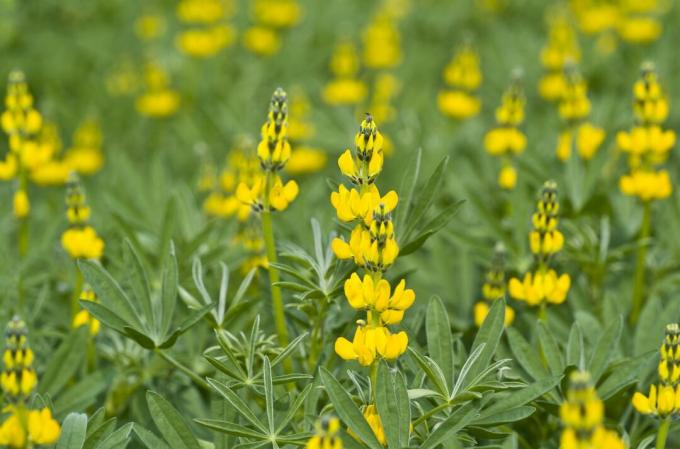
Lupins (Lupinus) are probably the most colorful representatives of the legumes (Fabaceae) and belong in every cottage garden. They impress with their large inflorescences, which represent an ideal background planting in the perennial bed. After flowering, the other benefits of the plants come to the fore. The seeds are high in protein and offer a regional alternative to soy. You can also improve any bed by planting lupins, because the plants loosen up soil and bind atmospheric nitrogen. In return, lupins only want a little sun, because otherwise they are extremely frugal in terms of location and care.
contents
- Lupins: characteristics and origin
- Lupins: Differentiate toxic from non-toxic lupins
- Lupins as a valuable food
- Lupins as green manure in the vegetable garden
-
Lupins in the garden
- Planting lupins: Suitable location
- Planting Lupins: Proper Approach When Planting
-
Lupins multiply themselves
- Sowing lupine seeds
- Propagate lupins by cuttings
-
Maintaining lupins in the garden
- Water and fertilize lupins properly
- Cut lupins properly
-
How do you harvest lupine seeds?
- When can you harvest lupine seeds?
- How do you harvest lupine seeds?
Lupins: characteristics and origin
The mostly herbaceous, perennial plants from 0.3 to 1.5 meters in size have their origin in North America. The plant, which now grows wild here, came to Europe at the beginning of the 19th century. Century. In Central Europe one meets most frequently the many-leaved lupine (Lupinus polyphyllus) at. Other important crops are the yellow lupine (Lupinus luteus), the white lupine (Lupinus albus) and the narrow-leaved lupine (Lupinus angustifolius), which, like the many-leaved lupine, blooms blue and, as a cultivated form, also blooms red. Lupins are one of the richest vegetable sources of protein. Hildegard von Bingen used them in preparations to heal all kinds of diseases. Lupine is said to have anti-cancer, antioxidant and antimicrobial effects. It is also suitable for diets related to protein deficiency diseases, diabetes, rheumatism, skin and stomach diseases.
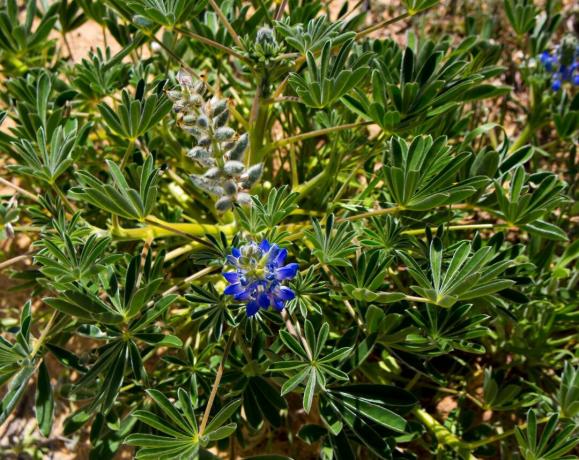
Lupins: Differentiate toxic from non-toxic lupins
The seeds of garden and wild lupins contain a poisonous bitter substance. The contained lupinine and sparteine can lead to respiratory paralysis and even death if consumed. However, since the 1930s there have been certain cultivated forms that do not contain the bitter substance or only contain it in very small quantities and are therefore non-toxic. Due to the absence of bitter substances, they were given the name sweet lupins. Lupins can only become a problem for allergy sufferers who are hypersensitive to legumes. The keyword here is: peanut allergy. More about Toxicity of Lupins Is there... here.
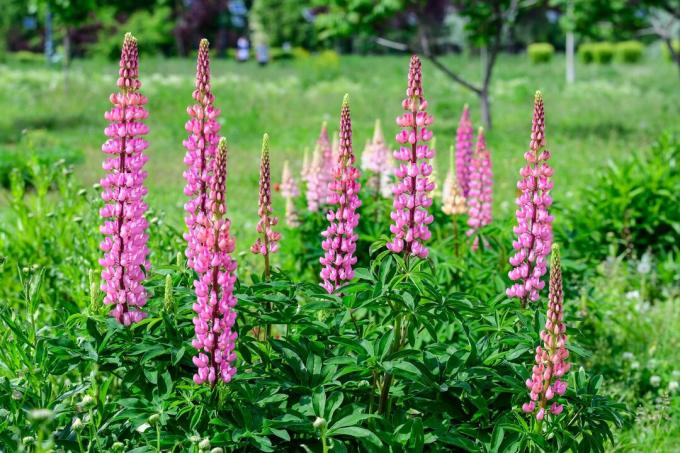
Lupins as a valuable food
Before we can include the seeds of the lupins in our nutrition plan, they have to be processed. Earlier varieties had to be soaked in salt water for 14 days, the sweet lupine seeds are only soaked for 1 to 2 days. This removes the last bitter substances. Such pickled seeds are a popular beer snack in restaurants in the Mediterranean region. But you can also process the seeds in a variety of ways. This gives you interesting alternatives for lactose intolerants, vegans and low-carb fans.
-
Lupine flour
Lupins are mostly processed into protein-containing flour. The protein content can be up to 40%. That is about four times more than with whole wheat flour. The high water retention makes the flour particularly interesting for vegans, as no eggs have to be used in baking. The high content of antioxidants also makes the baked goods last longer. However, the flour still has a very strong taste of its own, which is why it is recommended to keep the content at around 15-25% when baking. Otherwise you get a yellowish color and a nutty taste. -
Lupine coffee
This is all about a substitute for the wonderful taste of coffee, because the lupine coffee does not contain caffeine. Thus, the stimulating effect is absent. In return, the taste scores with a slight hint of autumn leaves and almonds. For the production, the seeds are dried and then roasted. The lupine seeds refined in this way have a very strong, harmonious aroma, as they are roasted at low temperatures and therefore hardly contain any bitter substances. The beans are ground and prepared like normal coffee beans. -
Lupine yogurt
Lupine yogurt is a creamy alternative for vegans. This is obtained from lupine milk and is now available in different flavors from natural to raspberry to stracciatella. The consistency is a little thicker than normal yogurt.

A large selection of others Lupine products and simple instructions for making a delicious spread can be found here.
Lupins as green manure in the vegetable garden
A planting with lupins is great for preparing harvested or newly planted vegetable beds. Because lupins are very hardy and can be sown even after the vegetables have been harvested. They are also very good nitrogen fertilizers. They enrich the soil with up to 100 kg of nitrogen per hectare. These vast amounts of nitrogen are fixed by a symbiosis between the lupine roots and nodule bacteria (rhizobia). In addition, the roots also penetrate compacted soil. This is loosened up and more permeable for subsequent crops. Particularly deep-rooted varieties such as the yellow lupine (L. luteus), the narrow-leaved lupine (Lupinus angustifolius) or the white lupine (L. albus) are well suited for this. After winter, the annual plants are mown and the cut is left as a layer of mulch. Once the layer has dried, it is worked into the soil. This is how the nitrogen gets into the soil and nutrient-rich humus is created. The first new plants can be planted after four weeks.

Lupins in the garden
Lupins are not only suitable as vegetables, fodder and wild plants. With their up to 50 cm high inflorescences in white, yellow, blue-violet, pink, orange or multi-colored, they have also found their way into our gardens as an ornamental plant. Mostly variants of the many-leaved lupine (Lupinus polyphyllus) - also called herbaceous lupine - offered.
Note: Westcountry lupins impress with their particularly intense flower colors.
Planting lupins: Suitable location
Especially when it comes to the soil, there is not much to consider when choosing a location. The roots of the lupine are strong and, thanks to their good nitrogen fixation, lupins also grow well on very sandy and poor soils. The following applies to the protein-rich crops:
- Location: open, sunny and sheltered from the wind
- Soil: Moderately rich in nutrients, well drained and poor in lime
Lupins also accept shadier spots. However, the flowering and stability of the plants suffer as a result. If the soil is too calcareous (basic soil pH), the leaves will turn yellow. Waterlogging is also not tolerated.

Planting Lupins: Proper Approach When Planting
Lupins are best planted in small groups in the bed. Here they form a brightly colored background for smaller perennials. The process of planting is as follows:
- Planting time: early autumn or spring
- Plant spacing: approx. 50 cm
- Planting hole: min. as deep as the root
- Carefully place the plant in the planting hole
- Fill with soil and press down
- Water well
- Water well for the next few days, but avoid waterlogging
If lupins are planted too densely, there is an increased risk of mildew. In addition, because of their deep roots, lupins are only suitable for pot cultivation to a very limited extent. If you still want to grow lupins in pots, stick to small-growing varieties, use a very high pot and have to overwinter the plants in a protected place in winter.
Lupins multiply themselves
Lupins are very easy to multiply by dividing, sowing or cuttings.
Sowing lupine seeds
In areas that have already been planted, lupins would look by themselves. The seeds fly up to six meters. The strong self-sowing means that lupins can quickly displace native wild plants in places they have once colonized. Hence the many-leaved lupine (Lupinus polyphyllus) with us as an invasive species. If you don't have lupins in your garden, you can sow the seeds yourself. The following is sown directly in the bed:
- Sowing time: March - May
- Lightly roughen the seeds with sandpaper and leave to soak in water for 24 hours
- Sowing depth: 2 - 3 centimeters
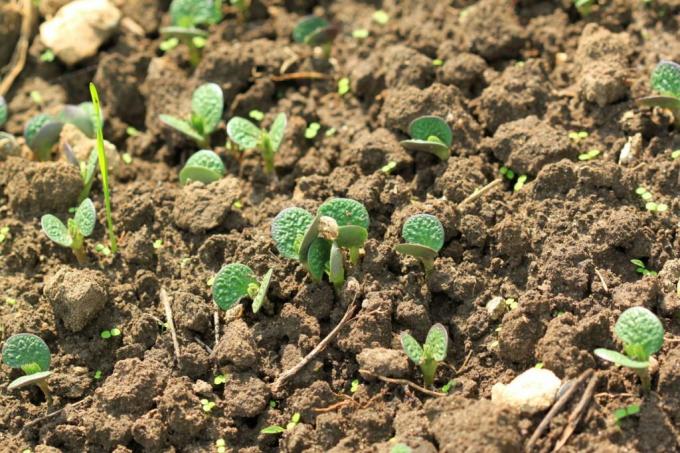
The seeds can also be grown indoors in the pot from January. From June onwards, the small lupins move outside. Perennial lupine species can also be sown until the end of August if necessary. Regardless of whether it is grown directly in the bed or in the pot, the first flowering does not start until the following year.
more on the subject Lupine seeds You will find here.
Propagate lupins by cuttings
Propagation via cuttings also works without any problems. The 5 to 10 centimeter long cuttings are cut in spring. Then proceed as follows:
- Remove all but the top one or two leaves
- Fill the growing pots with a loose substrate such as expanded clay
- Insert cuttings halfway into the substrate
- Location: warm and not full sun
- Keep the substrate evenly moist
- After the rooting (after four to six weeks) place them individually in pots with soil
- Transplant into the bed after a further six weeks

Maintaining lupins in the garden
Lupins don't need a lot of attention because they can take care of themselves quite well. But they should be rejuvenated about every three years. For this purpose, the rhizome is dug up in spring and the new shoots are replanted.
Water and fertilize lupins properly
As such, once lupins have grown, they don't need to be watered because of their very deep roots. If after a long period of dryness it is watered or it has rained heavily, it is worth loosening up the earth around the colorful protein bombs. This promotes long flowering. This also prevents the soil from becoming compacted, which is very beneficial to the plants that are sensitive to waterlogging.
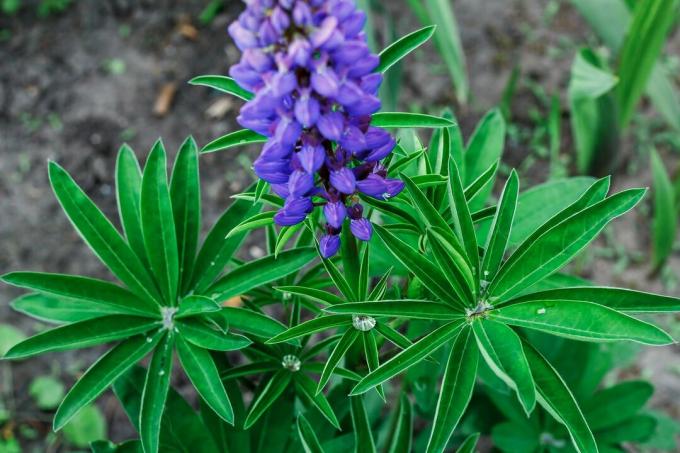
When it comes to fertilization, too, the motto is: less is more. You can overfertilize the plants very quickly, increasing the risk of root rot and other diseases and pests. Especially with nitrogen, lupins can supply themselves due to the symbiosis with bacteria. The additional mixing of rock flour or algae lime in the soil promotes this symbiosis. If you want to strengthen the stems of the plants, some of which grow three meters high, fertilize with a primarily organic bio-fertilizer like ours Plantura organic flower fertilizer with long-term effect.
Cut lupins properly
Lupins don't need to be cut into shape. But if the perennials have grown too big, the flower stalks can simply be cut back to the desired height. The pruning after flowering is more important. If the flowers are cut back immediately after flowering, this will encourage re-flowering in summer. In addition, dead flowers should be removed so that the lupins do not spread uncontrollably in the garden. Sick leaves should be removed immediately all year round to prevent diseases such as powdery mildew from spreading. It is not necessary to cut back above the ground in autumn. On the contrary: the upper part of the plant serves as winter protection for the roots and as green manure for the next year.
Maintaining lupins in the garden: summary
- Rejuvenate every three years
- Pouring: no longer necessary after waxing; Avoid waterlogging
- Fertilizing: sensitive to over-fertilization; Stone meal or algae lime promote the symbiosis with nodule bacteria; Bone meal strengthens the stems
- Sheath: remove inflorescences after flowering; remove diseased leaves
How do you harvest lupine seeds?
The pea-like inflorescences appear from late May to early August. From them pods are formed which contain several of the coveted seeds. Only harvest seeds for consumption if you are sure about the bitter substance content. Especially with crosses that have arisen in your own garden, the bitter substances that have been bred away from the sweet lupine varieties may come through again in the next generation. There is a high risk of poisoning here. If you are going to use the seeds for propagation, you need not worry.
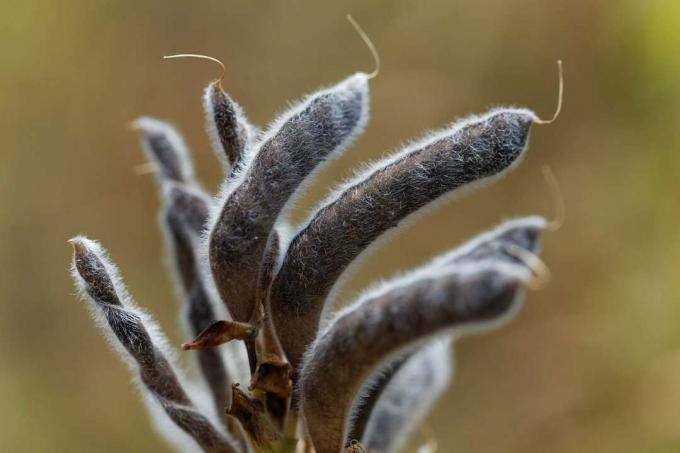
When can you harvest lupine seeds?
Harvesting takes place in late summer when the seeds are fully ripe. You can recognize ripe fruits by the fact that the pods are dry and dark.
How do you harvest lupine seeds?
The seeds can be easily pressed out of the mature pods. Ripe seeds have a nice dark color. The seeds are cleaned with water and then dried so that they can be stored. In a screw-cap jar in a cool, dark place, the seeds will still be able to germinate after two to three years.
The harvested lupine seeds can be processed in a variety of ways. Check out our special article to learn more about how to Harvest and use lupine seeds can.
